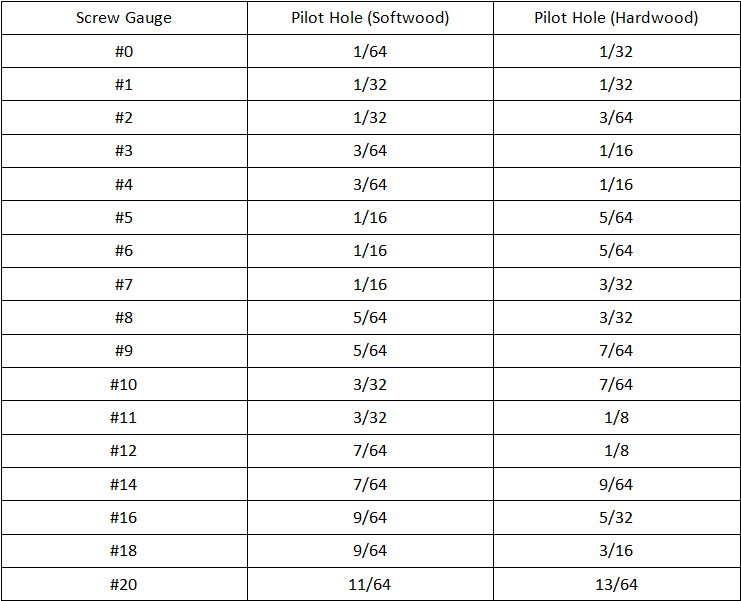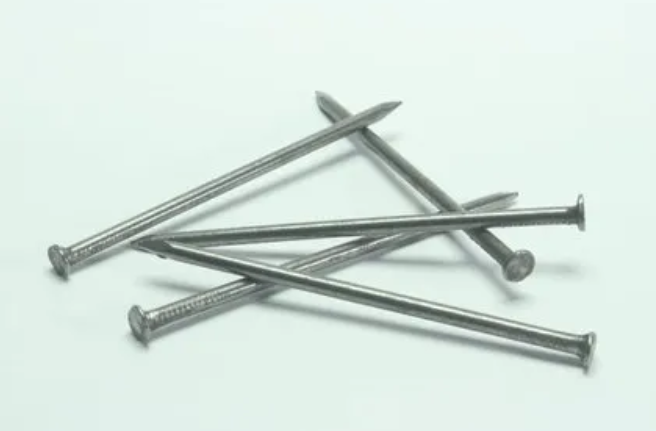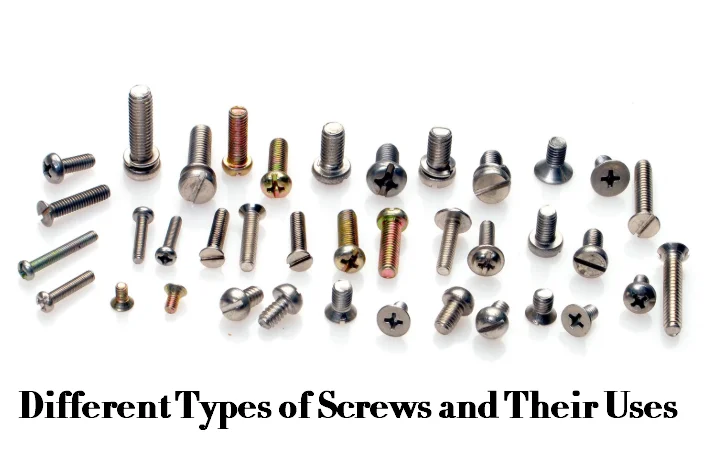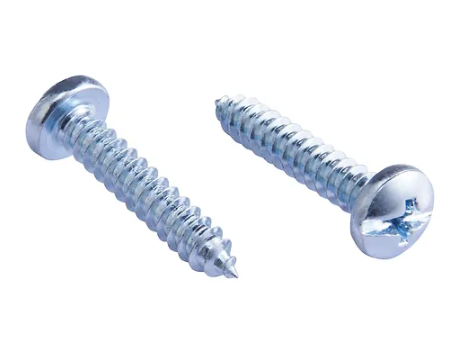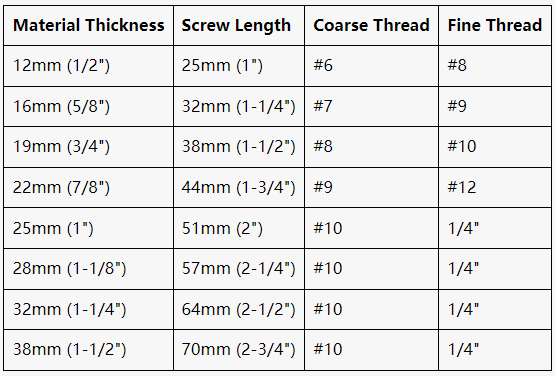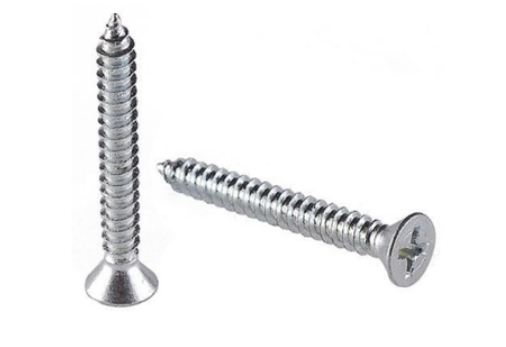Have you ever wondered how to make sure your screws go in smoothly without damaging the material? That’s where a pilot hole comes into play. Pilot holes are a fundamental part of many manufacturing and assembly processes. They help ensure that parts fit together accurately and securely. When you are working on a woodworking project or assembling complex machinery, drilling an accurate pilot hole for your project can make a significant difference in the quality of your work. So before you drive in the fastener, make sure to know what size pilot hole to have precision holes for your screws or bolts. Check out the Pilot Hole Size Chart with diameter and drill bit dimensions for standard wood, steel, aluminum, plastic, and lag screws in the market!

What is a Pilot Hole?
A pilot hole is a small hole drilled into a material, often wood or metal, before inserting a screw or fastener. This technique is vital in various manufacturing processes, especially in assembly and joinery.
What is the Purpose of a Pilot Hole?
The primary purpose of a pilot hole is to guide the screw or fastener into place. By creating this small opening, you reduce the risk of splitting the material. This is particularly important in woodworking where a well-placed pilot hole can save your project from insightly cracks.
When to Drill a Pilot Hole?
The three most common reasons when you’ll need to drill a pilot hole is when you’re drilling into very dense and hard materials such as hardwood or laminate, a second reason would be if you need very precise screw locations in your materials, and a third reason is if you’re drilling near the edge or the end of a piece of material to keep that material from splitting.
Where is the Pilot Hole Used For?
Pilot holes are not just for woodworking. They are also important in industries like aerospace manufacturing. In this field, precise pilot holes are vital for ensuring the structural integrity of aircraft components. Every detail matters when it comes to safety and performance.
What Size Pilot Hole?
When it comes to the size of the pilot hole, it should be slightly smaller than the diameter of the screw or fastener being used. This snug fit ensures that the screw holds securely without causing damage to the surrounding material. For example, if you are using a screw that is 1/4 of an inch in diameter, your pilot hole should typically be around 1/8 of an inch.
How to Determine Pilot Hole Size for Wood Screws & Bolts?
To find the correct pilot hole size for wood screws, hold a drill bit in front of your screw. The threads of the screw should be visible on both sides of the drill bit. If a good amount of the threads can be seen, that drill bit is likely the right size. If more threads are visible, a smaller bit may be even better. If only a little bit of the threads can be seen, the bit is probably too large.
Another accurate method is to use a caliper to measure the shank of the screw, then select a drill bit with a diameter just a little bit less than the shank. The shank is the solid center section that the threads wrap around.
Pilot hole charts are also useful and provide information on what size bit to use for different screw sizes and materials. For example, for a number six screw, use a 7/64 inch bit for softwoods and a 3/32 inch bit for hardwoods.
When drilling a pilot hole in wood, the drill bit should be the same diameter as the screw’s shank. Drill the hole to the depth of the screw, then insert the screw into the pilot hole. Drilling a pilot hole helps prevent splitting, especially when working near the edge or with hardwood.
How To Determine Pilot Hole Size for Metal Screws & Bolts?
For metal screws, the pilot hole needs to be large enough for the screw to cut threads into the metal without excessive force. The drill bit should be slightly smaller than the screw’s diameter so the threads can grip the metal securely.
A screw gauge or caliper can be used to measure the screw diameter. Pilot hole size charts for metal screws are widely available and provide the recommended drill bit size for each screw size. Using these charts ensures that the pilot hole is accurate and that the screw will hold firmly.
Pilot Hole Size Chart (Diameter & Drill Bit)
To help save you work and quickly determine what size pilot hole for your project, here we list standard pilot hole size charts for the most used wood, metal, and lag screws in the market now!
Pilot Hole Size Chart for Standard Screws
| Screw Size | Threads per Inch (TPI) | Type AB/B/25 Self-Tapping Screws | Type A Self-Tapping Screws | Type F/1/23 Thread Cutting Screws | High-Low Thread Forming Screws (≤200k psi) | High-Low Thread Forming Screws (>200k psi) | U-Drive Screws | Thread Forming Screws for Plastics Soft/Brittle | |||||||
|---|---|---|---|---|---|---|---|---|---|---|---|---|---|---|---|
| Hole Diameter | Drill Bit | Hole Diameter | Drill Bit | Hole Diameter | Drill Bit | Hole Diameter | Drill Bit | Hole Diameter | Drill Bit | Hole Diameter | Drill Bit | Soft | Brittle | ||
| #0 | 40 | 0.0498″ | 0.0490″ | ||||||||||||
| #2 | 32 | 0.0760″ | #48 | 0.0760″ | #48 | 0.0730″ | #49 | 0.067″ | #51 | 0.070″ | #50 | 0.086″ | #44 | 0.0760″ | 0.0800″ |
| #3 | 28 | 0.0810″ | #46 | 0.0810″ | #46 | 0.0810″ | #46 | 0.073″ | #49 | 0.078″ | 5/64″ | 0.0880″ | 0.0940″ | ||
| #4 | 24 | 0.0860″ | #44 | 0.0860″ | #44 | 0.0960″ | #41 | 0.081″ | #46 | 0.086″ | #44 | 0.1000″ | 0.1060″ | ||
| #5 | 20 | 0.1065″ | #36 | 0.1065″ | #36 | 0.1010″ | #37 | 0.094″ | #42 | 0.100″ | #39 | 0.1110″ | 0.1170″ | ||
| #6 | 20 / 18 / 19 | 0.1160″ | #32 | 0.1160″ | #32 | 0.1200″ | #31 | 0.102″ | #38 | 0.110″ | #35 | 0.1220″ | 0.1280″ | ||
| #7 | 19 / 16 | 0.1285″ | #30 | 0.1285″ | #30 | 0.120″ | #31 | 0.125″ | 1/8″ | 0.1340″ | 0.1420″ | ||||
| #8 | 18 / 15 / 16 | 0.1360″ | #29 | 0.1360″ | #29 | 0.1470″ | #26 | 0.120″ | #31 | 0.129″ | #30 | 0.1490″ | 0.1580″ | ||
| #9 | 15 | 0.1620″ | 0.1720″ | ||||||||||||
| #10 | 16 / 12 / 24 / 14 | 0.1590″ | #21 | 0.1590″ | #21 | 0.1730″ | #17 | 0.136″ | #29 | 0.144″ | #27 | 0.161″ | #20 | 0.1750″ | 0.1850″ |
| #12 | 24 / 11 / 16 | 0.1875″ | 3/16″ | 0.1875″ | 3/16″ | 0.1990″ | #8 | 0.157″ | #22 | 0.166″ | #19 | 0.191″ | #11 | 0.1950″ | 0.2050″ |
| #14 / 1/4″ | 14 / 10 / 15 | 0.2188″ | 7/32″ | 0.2188″ | 7/32″ | 0.189″ | #12 | 0.201″ | #7 | 0.221″ | #2 | 0.2240″ | 0.2400″ | ||
| 5/16″ | 12 / 9 / 14 | 0.2720″ | I | 0.2900″ | L | 0.2900″ | L | 0.238″ | #B | 0.250″ | 1/4″ (E) | 0.2860″ | 0.3030″ | ||
| 3/8″ | 12 / 9 / 16 | 0.3281″ | 21/64″ | 0.3438″ | 11/32″ | 0.3580″ | T | ||||||||
| 1/2″ | 13 | 0.4531″ | 29/64″ | ||||||||||||
Wood Screw Pilot Hole Drill Size Chart
| Screw Szie | Body Dia. | Shank Pilot Hole | Pilot hole in Softwood | Pilot Hole in Hardwood |
|---|---|---|---|---|
| #0 | 0.060 | 1/16 | 1/64 | 1/32 |
| #1 | 0.073 | 5/64 | 1/32 | 1/32 |
| #2 | 0.086 | 3/32 | 1/32 | 3/64 |
| #3 | 0.099 | 7/64 | 3/64 | 1/16 |
| #4 | 0.112 | 7/64 | 3/64 | 1/16 |
| #5 | 0.125 | 1/8 | 1/16 | 5/64 |
| #6 | 0.138 | 9/64 | 1/16 | 5/64 |
| #7 | 0.151 | 5/32 | 1/16 | 3/32 |
| #8 | 0.164 | 11/64 | 5/64 | 3/32 |
| #9 | 0.177 | 3/16 | 5/64 | 7/64 |
| #10 | 0.190 | 3/16 | 3/32 | 7/64 |
| #11 | 0.203 | 13/64 | 3/32 | 1/8 |
| #12 | 0.216 | 7/32 | 7/64 | 1/8 |
| #14 | 0.242 | 1/4 | 7/64 | 9/64 |
| #16 | 0.268 | 17/64 | 9/64 | 5/32 |
| #18 | 0.294 | 19/64 | 9/64 | 3/16 |
| #20 | 0.320 | 21/64 | 11/64 | 13/64 |
| #24 | 0.372 | 3/8 | 3/16 | 7/32 |
Sheet Metal Pilot Hole Drill Size Chart (Steel, Stainless Steel, Aluminum, Monel Metal, Brass)
| Screw Size | Metal Thickness | Pierced or Extruded Hole Size | Drilled or Clean Punched Hole Size | Drill Size |
|---|---|---|---|---|
| 4 | 0.015 | — | 0.086 | 44 |
| 4 | 0.018 | — | 0.086 | 44 |
| 4 | 0.024 | 0.098 | 0.094 | 42 |
| 4 | 0.030 | 0.098 | 0.094 | 42 |
| 4 | 0.036 | 0.098 | 0.098 | 40 |
| 6 | 0.015 | — | 0.104 | 37 |
| 6 | 0.018 | — | 0.104 | 37 |
| 6 | 0.024 | 0.111 | 0.104 | 37 |
| 6 | 0.030 | 0.111 | 0.104 | 37 |
| 6 | 0.036 | 0.111 | 0.106 | 36 |
| 7 | 0.015 | — | 0.116 | 32 |
| 7 | 0.018 | — | 0.116 | 32 |
| 7 | 0.024 | 0.120 | 0.116 | 32 |
| 7 | 0.030 | 0.120 | 0.116 | 32 |
| 7 | 0.036 | 0.120 | 0.116 | 32 |
| 7 | 0.048 | 0.120 | 0.120 | 31 |
| 8 | 0.015 | — | 0.125 | 1/8 |
| 8 | 0.018 | — | 0.125 | 1/8 |
| 8 | 0.024 | 0.136 | 0.125 | 1/8 |
| 8 | 0.030 | 0.136 | 0.125 | 1/8 |
| 8 | 0.036 | 0.136 | 0.125 | 1/8 |
| 8 | 0.048 | 0.136 | 0.128 | 30 |
| 10 | 0.018 | — | 0.136 | 29 |
| 10 | 0.024 | 0.157 | 0.136 | 29 |
| 10 | 0.030 | 0.157 | 0.136 | 29 |
| 10 | 0.036 | 0.157 | 0.136 | 29 |
| 10 | 0.048 | 0.157 | 0.149 | 25 |
| 12 | 0.024 | — | 0.161 | 20 |
| 12 | 0.030 | 0.185 | 0.161 | 20 |
| 12 | 0.036 | 0.185 | 0.161 | 20 |
| 12 | 0.048 | 0.185 | 0.161 | 20 |
| 14 | 0.024 | — | 0.185 | 13 |
| 14 | 0.030 | 0.209 | 0.189 | 12 |
| 14 | 0.036 | 0.209 | 0.191 | 11 |
| 14 | 0.048 | 0.209 | 0.196 | 9 |
Lag Screw (Bolt) Pilot Hole Size Chart (Wood Types & Standard)
| Lag Bolt Size (Nominal Diameter, in.) | Pilot Hole Size (inches) | Standard Shank (Unthreaded) Portion | Standard Pilot Hole (Thread Portion) | ||
|---|---|---|---|---|---|
| Soft Wood | Medium Wood | Hard Wood | |||
| 1/4″ | 3/32″ | 5/32″ | 3/16″ | ||
| 5/16″ | 9/64″ | 3/16″ | 13/64″ | ||
| 3/8″ | 11/64″ | 15/64″ | 1/4″ | 3/8″ | 15/64″ |
| 1/2″ | 15/64″ | 5/16″ | 11/32″ | 1/2″ | 5/16″ |
| 5/8″ | 5/16″ | 13/32″ | 29/64″ | 5/8″ | 13/32″ |
| 3/4″ | 13/32″ | 1/2″ | 9/16″ | 3/4″ | 1/2″ |
| 7/16″ | 7/16″ | 9/32″ | |||
| 9/16″ | 9/16″ | 23/64″ | |||
| 7/8″ | 7/8″ | 39/64″ | |||
| 1″ | 1″ | 23/32″ | |||
| 1 1/8″ | 1 1/8″ | 53/64″ | |||
| 1 1/4″ | 1 1/4″ | 15/16″ | |||
* Soft Wood (Group 3 and 4), Medium Wood (Group 2), Hard Wood (Group 1).
* “Standard Shank (Unthreaded) Portion” and “Standard Pilot Hole (Thread Portion)” columns are based on commonly accepted engineering tables for lag screw pilot holes.
How To Drill a Pilot Hole?
First, use a drill bit that is the same size as the shank of the screw. The shank is the solid center section that the threads wrap around. An easy way to select the correct bit is to hold the drill bit in front of the screw, if the shank is hidden but the threads are still visible, the drill bit is the right size.
Insert the drill bit into the drill and set the clutch to the highest setting. Drill a hole to the same depth as the screw. To help gauge the depth, a piece of painter’s tape can be wrapped around the drill bit at the desired length.
Once the pilot hole is drilled, insert and drive the screw into the hole.
How To Choose the Pilot Hole Drill Bit?
In the manufacturing of drill bits, which are used to create these pilot holes, precision is key. Manufacturers design drill bits to be sharp and accurate. A sharp drill bit minimizes the risk of material damage and ensures that the pilot hole is drilled cleanly. This is essential for achieving a smooth assembly process.
Do You Always Need A Pilot Hole For Self Drilling Screws?
do you need a pilot hole for self-drilling screws self-drilling screws do not always need a pilot hole before installation. Plastic, wood, and composite substrate materials will not need a pilot hole drilled for them when the substrate is a tough material like metal or masonry; then, pilot holes could become necessary. Self-tapping screws will require pilot holes on tough materials!
When Don’t You Need to Drill a Pilot Hole?
If drilling directly into soft materials and precision is not required, a pilot hole is not needed.


